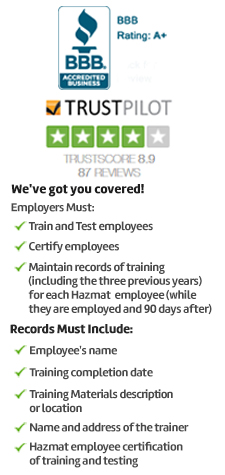
IATA DGR Class 1 Training

Transporting hazardous commodities from one place to another needs to be done with at most care as a slightest slippage can leads to catastrophe. Hence, it is important to know precautions, procedures, compliances and standard safety practices in handling such dangerous cargo.
The IATA DGR Class 1 Training & Certification Course which deals with procedures to send explosives by air transport, educates learners about the standard regulations in handling explosives, procedures to send them via air, responsibilities of transporters and shipping agencies and safe methodology to identify, record, package, label, mark, handle and load every consignment classified as hazardous goods.
The course also includes module to handle Class 1 category explosives and explains step-by-step procedures to identify, safety needs and precautions taken while handling and transporting explosives through air transport.
Governing regulations
Explosives shipped via airplane have stringent formalities governed by the IATA Class 1 Dangerous Goods Regulations.
This online course aims to address standard procedures required, including FedExand UPS.
If transporters want to ship other categories of dangerous goods, instead of this course, they should take our full IATA Dangerous Goods Regulations training course.
Course Overview
This course deals with all basic concepts such as how to comply with IATA Dangerous Goods Regulations, responsibilities of shippers and operators and the proven methods to identify, register, pack, sketch, handle, label and load various categories of hazardous goods. The course also provides students with statistical analysis and important case studies to make them understand the importance of dangerous goods regulations for air transport.
Who Must Take this Course?
IATA DGR warrants that training must be provided to all workers who are identified in Table 1.5.A which include: Airline cargo acceptance staff, packers and freight forwarders, shippers, cargo training and development specialists, regulatory compliance specialists, ground handling and goods control staff involved in the cargo chain, operations and station managers and security screeners.
How long is the course?
This short term online course will take a MINIMUM of three hours to complete. But there is no time restriction for students as they can complete the course as per their available time. Once they begin their course, they can log on and off as needed. Learners can create a bookmark whenever they log off and come back to resume their study from where they left.
How long do I have to complete this course?
Students do not have restrictions on completing the course within a specific period,
Similarly, if you are buying courses for others, there is no time limit for you assign the courses to your acquaintances or staff. You can also purchase several courses at a time and avail bulk order discounts.
Continuing education credits?
Each student will receive 0.3 CEUs (or 3 CMEs) from Compliance Training Online® for completing this online course for safe transportation of explosive materials.
Course Format
Our IATA Dangerous Goods Regulations Shipping Class 1 training and certification course contains quality content, graphics, audio, practice questions and a final exam.
Course synopsis.
This course deals with all basic concepts such as how to comply with IATA Dangerous Goods Regulations, responsibilities of shippers and operators and the proven methods to identify, register, pack, sketch, handle, label and load various categories of hazardous goods. The course also provides students with statistical analysis and important case studies to make them understand the importance of dangerous goods regulations for air transport.
How often is retraining or recertification required?
As per IATA DGR regulations – Training must be given within two years (24 months) from the date of previous training, unless a relevant authority suggests a shorter period.
Topics Covered
- About This Course
- Course Objectives
- Introduction to Dangerous Goods Regulations
- Philosophy of Dangerous Goods Regulations
- Key Terms and Concepts
- Dangerous Goods Incidents and Statistics
- How to Use the DGR
- Changes to the 59th Edition
- Applicability
- Basis of the IATA Dangerous Goods Regulations
- Application of the Regulations
- Shipper’s Responsibilities
- Operator’s Responsibilities
- Training
- Adequate Instruction for Shipping Section II Lithium Batteries
- Security
- Limitations
- Forbidden Dangerous Goods
- Hidden Dangerous Goods
- Dangerous Goods Carried by Passengers or Crew
- Dangerous Goods Transported by Post
- Operator’s Property Exceptions
- Excepted Quantities
- Limited Quantities
- Variations
- Classification
- Packing Groups
- Shipper’s Responsibilities
- Multiple Hazards
- Samples
- Identification
- Selecting the Proper Shipping Name
- Using the List of Dangerous Goods
- Packing
- Shipper’s Responsibilities
- Overpacks
- Salvage Packaging
- General Packing Requirements
- Specific Packing Instructions
- Packaging Specifications and Performance Tests
- Codes
- Markings
- Requirements for Inner Packagings
- UN Outer, Single, and Composite Packagings
- General Testing Requirements
- Types of Tests
- Test Reports
- Specific Testing Requirements
- Marking and Labeling
- Markings
- Labels
- General Label Specifications
- Hazard Labels
- Handling Labels
- Documentation
- Shipper’s Declaration
- Completing the Shipper’s Declaration
- Air Waybill
- Additional Documentation
- Handling
- Acceptance
- Loading
- Inspections
- Provisions for Pilot-in-Command
- Informing Passengers and Shippers
- Reporting
- Document Retention
- Class 1 Explosives
- Definitions
- Primary Hazards
- Six Divisions
- Thirteen Compatibility Groups
- Classification
- Exclusions and Limitations
- Packing Instructions
- Labels
- Summary
- Additional Resources

 NEBOSH CERTIFICATE
NEBOSH CERTIFICATE NEBOSH DIPLOMA
NEBOSH DIPLOMA IOSH
IOSH SAFETY DIPLOMA
SAFETY DIPLOMA CPD UK
CPD UK ROSPA UK
ROSPA UK FOOD SAFETY
FOOD SAFETY 



